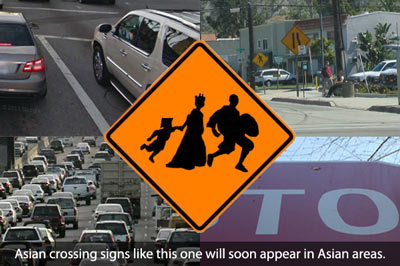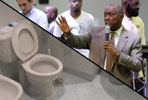Los Angeles To Install "Asian Crossing" Signs To Protect Ethnic Pedestrians
 Tuesday, March 5, 2013 at 4:08AM
Tuesday, March 5, 2013 at 4:08AM By ADRIAN MARKS
Related story: State Assembly Debates Asian Driving Statute
 Almost on year ago, UCLA Pan-Asian Student Union President Wujun Chen was struck down by a car while she was crossing Wilshire Blvd. in Westwood. Her death prompted calls in Westwood and across the L.A. region for warning signs for Asian crossings.
Almost on year ago, UCLA Pan-Asian Student Union President Wujun Chen was struck down by a car while she was crossing Wilshire Blvd. in Westwood. Her death prompted calls in Westwood and across the L.A. region for warning signs for Asian crossings.
After much deliberation, the Los Angeles City Council finally unanimously approved a design for the Asian crossing sign that will be installed at intersections in Westwood and Koreatown. Japantown might also receive a number of signs, although it is considered a lower risk area.
Chen’s parents, Ken and Shiuan Chen of Monterey Park, both expressed gratitude that the sign’s design was finally complete and that it would be installed soon. “We will never be able to replace Wujun, but it is good that they are doing sumting [phonetic] about this problem.”
The story of the Asian crossing sign is much like the story of Los Angeles’ own diversity. Although most Americans are unaware of it there are many types of Asians, and in Asia they consider themselves distinct groups. Since the Asian crossing sign will be used in various Asian neighborhoods, different Asian ethnicities wanted to have input and feel empowered.
“We wanted to include all Asian communities and also have a sign with a clear message to motorists.”
Local businessman and restaurateur John Yoon was appointed by the City Council to find a design agreeable to the local Asian communities. “We wanted to include all Asian communities and also have a sign with a clear message to motorists,” said Yoon. The result: a sign that borrows from the trademark in legal alien crossing sign but instills traditional Asian clothing. “The sign clearly alerts motorists that there are Asians walking in the area,” Yoon added.
In centuries past, the three figures might be more likely to find themselves at war than in familial bliss. The warrior figure is a Chinese warrior carrying a traditional “dao” sword. “The Chinese community felt slightly sheepish about the sign,” said Yoon. “Therefore, they wanted their figure to show strength and vitality – not weakness.” The other figures feature a woman traditional Japanese geisha attire and a child wearing a Vietnamese non la (leaf hat).





Reader Comments